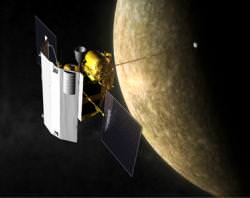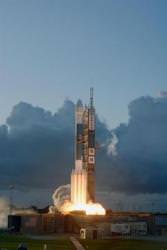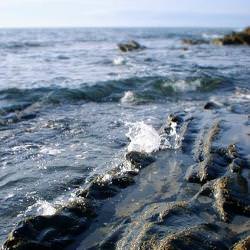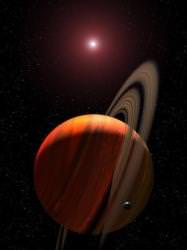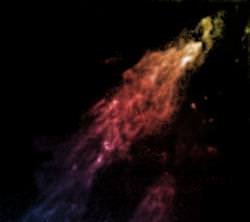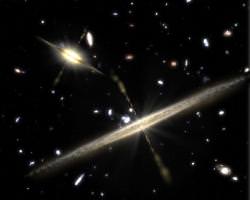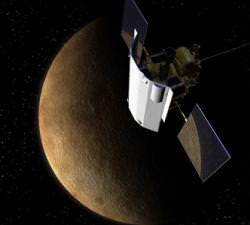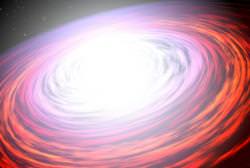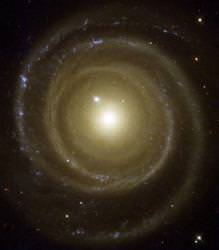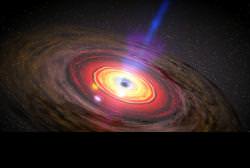2008 will be a busy year throughout the world and our solar system as various robotic and human missions are slated to begin their journeys of exploration and science. One of the most exciting and nail biting times of a mission is the launch, and following is a list of mission launches that will occur in 2008. Included is information about each mission and links to mission homepages, as well as launch locations, just in case you’ll be in the area. Of course, as the year rolls along, we’ll be covering each of the missions in Universe Today.
2008 Launches:
All launch dates are subject to change. The launches listed are non-military scientific robotic and human missions.
January 30: THEOS (Thailand Earth Observing System) (GISTDA)
Launch site: Yasny, in Orenburg Oblast, Russia Dombarovsky Cosmodrome, Russia
Launch vehicle: Kosmotras Dniepr rocket
THOES will be used for cartography, agricultural monitoring, forestry management, coastal zone monitoring and flood risk management in Thailand. The spacecraft was built by EADS Astrium in France.
Feb. 5: Progress 28P (Roskosmos)
Launch site: Baikonur Cosmodrome, Kazakhstan
Launch Vehicle: Soyuz
The 28th Progress cargo delivery ship to the International Space Station (ISS).
Feb. 7: Space Shuttle Mission: STS-122 (NASA)
Launch Site: Kennedy Space Center – Launch Pad 39A
Launch Vehicle: Space Shuttle Atlantis
STS-122 will deliver the Columbus European Laboratory Module to the ISS, and is the twenty-fourth mission to the space station.
February 22: ESA’s ATV Jules Verne (ESA)
Launch site: ELA-3, Kourou, French Guiana
Launch vehicle: Ariane 5
The European Space Agency’s first Automated Transfer Vehicle “Jules Verne� will dock with the ISS to bring supplies and equipment to the station.
Mid to Late March: Space Shuttle Mission: STS-123 (NASA)
Launch Vehicle: Space Shuttle Endeavour
Launch Site: Kennedy Space Center – Launch Pad 39A
Mission STS-123 will deliver the pressurized section of the Kibo Japanese Experiment Logistics Module (ELM-PS) on the twenty-fifth mission to the ISS.
April 8: Soyuz ISS 16S (Roskosmos)
Launch site: Baikonur Cosmodrome, Kazakhstan
Launch vehicle: Soyuz
Flight of the manned Soyuz TMA-12 spacecraft to the International Space Station with members of the Expedition 17 crew. The capsule will remain at the station for about six months, providing an escape vehicle for the crew.
April 9: Chandrayaan-1 (ISRO)
Launch site: Satish Dhawan Space Centre, India
Launch vehicle: India’s PSLV (Polar Satellite Launch Vehicle)
India’s lunar orbiter mission will create a 3-D atlas of the moon, as well as conduct chemical and mineral mapping of the entire lunar surface. NASA’s Chandrayaan webpage
April 24: Space Shuttle Mission STS-124 (NASA)
Launch Site: Kennedy Space Center – Launch Pad 39A
Launch Vehicle: Space Shuttle Discovery
Space Shuttle Discovery on mission STS-124 will transport the Kibo Japanese Experiment Module – Pressurized Module (JEM-PM) and the Japanese Remote Manipulator System (JEM-RMS) to the International Space Station.
May 14: Progress 29P (Roskosmos)
Launch site: Baikonur Cosmodrome, Kazakhstan
Launch Vehicle: Soyuz
The 29th Progress cargo delivery ship to the International Space Station (ISS).
May 15: GOCE satellite (Gravity field and steady state Ocean Circulation Explorer)(ESA)
Launch site: Plesetsk, Russia
Launch vehicle: Rokot / Briz KM
GOCE will measure the Earth’s gravity field and model the geoid, or hypothetical surface of the Earth, with extremely high accuracy and spatial resolution. It also will provide insight into the physics and dynamics of the Earth’s interior, such as volcanism and earthquakes.
May 16: GLAST (Gamma-ray Large Area Space Telescope) (NASA)
Launch Site: Cape Canaveral Air Force Station – Launch Complex 17 – Pad 17-B
Launch Vehicle: United Launch Alliance Delta II
GLAST the will have the ability to detect gamma rays in a range of energies from thousands to hundreds of billions of times more energetic than the light visible to the human eye. Radiation of such magnitude can only be generated under the most extreme conditions, thus GLAST will focus on studying the most energetic objects and phenomena in the universe, such as black holes, gamma ray bursts, neutron stars and cosmic rays. GLAST follows in the footsteps of the Compton Gamma Ray Observatory.
June 15: OSTM/Jason 2 (Ocean Surface Topography Mission)
Launch Site: Vandenberg Air Force Base – Launch Pad SLC-2
Launch Vehicle: United Launch Alliance Delta II
This will be a follow-on to the Jason mission to measure sea surface height and determine the variability of ocean circulation at decadal time scales with combined data from the Topex/Poseidon mission and Jason . This is a joint U.S., Canadian and European project.
July 15: IBEX (Interstellar Boundary Explorer)
Launch Site: Reagan Test Site, Kwajalein Atoll
Launch Vehicle: Orbital Sciences Pegasus XL Rocket
IBEX’s science objective is to discover the global interaction between the solar wind and the interstellar medium. It will take a set of global energetic neutral atom images to determine the strength and structure of the termination shock, and study the properties of the solar wind flow beyond the termination shock and in the heliotail.
July 20: GOES-O Geostationary Operational Environmental Satellite
Launch Site: Cape Canaveral Air Force Station – Launch Complex 17
Launch Vehicle: United Launch Alliance Delta IV
NASA and the National Oceanic and Atmospheric Administration (NOAA) are actively engaged in a cooperative program, the multimission series N-P. This series will be a vital contributor to weather, solar and space operations, and science. The weather satellite will orbit 22,300 miles above the planet to monitor conditions across the U.S.
July 31: Herschel–Planck (ESA)
Launch site: CSG, Kourou, French Guiana
Launch vehicle: Ariane 5
One rocket will launch two different spacecraft, the Herschel infrared space observatory and the Planck mission to study the cosmic microwave background radiation. Herschel is a 3.5 meter diameter reflecting telescope with instruments cooled to close to absolute zero to observe at wavelengths that not been previously explored. After a four-month journey from Earth, Herschel will spend at least three years in orbit around the second Lagrange point of the Sun-Earth system. Planck will image the anisotropies of the Cosmic Background Radiation Field over the whole sky.
Aug. 7: Space Shuttle Mission: STS-125 (NASA)
Launch Site: Kennedy Space Center – Launch Pad 39A
Launch Vehicle: Space Shuttle Atlantis
Space Shuttle Atlantis will fly seven astronauts into space for the fifth and final servicing mission to the Hubble Space Telescope. During the 11-day flight, the crew will repair and improve the observatory’s capabilities through 2013.
Aug. 12: Progress 30P (Roskosmos)
Launch site: Baikonur Cosmodrome, Kazakhstan
Launch vehicle: Soyuz rocket
The 30th Progress cargo delivery ship to the International Space Station.
Sept. 18: Space Shuttle Mission STS-126 (NASA)
Launch Site: Kennedy Space Center – Launch Pad 39A
Launch Vehicle: Space Shuttle Endeavour
ISS assembly flight ULF2 will deliver a Multi-Purpose Logistics Module to the International Space Station.
Oct. 12: Soyuz ISS 17S (Roskosmos)
Launch site: Baikonur Cosmodrome, Kazakhstan
Launch vehicle: Soyuz
The manned Soyuz TMA-13 spacecraft flies to the International Space Station with members of the Expedition 18 crew. The capsule will remain at the station for about six months, providing an escape vehicle for the crew
October TBD: SMOS (Soil Moisture and Ocean Salinity) & Proba-2 microsatellite (ESA)
Launch site: Plesetsk, Russia
Launch vehicle: Rokot
SMOS will measure microwave radiation emitted from the Earth’s surface at L-band (1.4 GHz) using an interferometric radiometer. Proba-2 is a technology demonstration satellite.
Oct. 28: LRO (Lunar Reconnaissance Orbiter) & LCROSS (Lunar Crater Observation and Sensing Satellite) (NASA)
Launch Site: Cape Canaveral Air Force Station – Launch Complex 41
Launch Vehicle: United Launch Alliance Atlas V
LRO will spend at least a year mapping the surface of the moon to help select safe landing sites for astronauts, identify lunar resources and study how the moon’s environment will affect humans. LCROSS will study the poles of the moon to confirm the presence or absence of water ice in a permanently shadowed craters.
Dec 1: SDO (Solar Dynamics Observatory) (NASA)
Launch Site: Cape Canaveral Air Force Station – Launch Complex 41
Launch Vehicle: United Launch Alliance Atlas V
SDO will help to understand the Sun’s influence on Earth and Near-Earth space by studying the solar atmosphere on small scales of space and time and in many wavelengths simultaneously. This is the first Space Weather Research Network mission in the Living With a Star Program of NASA.
Dec 15: OCO (Orbiting Carbon Observatory) (NASA)
Launch Site: Vandenberg Air Force Base, California – Launch Pad SLC 576-E
Launch Vehicle: Orbital Sciences Taurus Rocket
OCO will collect precise global measurements of carbon dioxide (CO2) in the Earth’s atmosphere to improve our understanding of the natural processes and human activities that may have an influence on this greenhouse gas. OCO is a new Earth orbiting mission sponsored by NASA’s Earth System Science Pathfinder Program.

